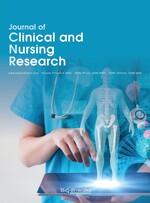Abstract
Objective: To analyze the effect of combined inhalation of budesonide formoterol and tiotropium bromide
on arterial blood gas and pulmonary function indexes in patients with chronic obstructive pulmonary disease (COPD). Methods: 100 patients with COPD treated from January to December 2022 were selected as observation objects, and were divided into a control group (n = 50, in which budesonide and formoterol were administered) and an experimental group (n = 50, the treatment drug was budesonide formoterol combined with tiotropium bromide) according to the computer grouping method, and compared the treatment results. Results: (i) Before treatment, there was no difference in the partial pressure of carbon dioxide and partial pressure of oxygen between the control group and the experimental group (P > 0.05); after treatment, the partial pressure of carbon dioxide and partial pressure of oxygen in the experimental group were higher than those in the control group, with significant differences (P < 0.05). (ii) Before treatment, there was no difference in forced vital capacity (FVC), forced expiratory volume in one second (FEV1), FEV1/FVC between the control group and the experimental group (P > 0.05); after treatment, the FVC, FEV1, and FEV1 /FVC in the experimental group were
significantly higher than those in the control group (P < 0.05). (iii) There was no difference in the levels of CRP, IL-6, and TNF-α between the control group and the experimental group (P > 0.05); after treatment, the levels of CRP, IL-6, and TNF-α in the experimental group were lower than those in the control group, with significant differences (P <0.05). (iv) Compared to the total incidence of adverse reactions in the control group (28.00%), the incidence of total adverse reactions in the experimental group was lower at 10.00%, and the difference was significant (P < 0.05). Conclusion: The combined inhalation of budesonide and formoterol with tiotropium bromide has demonstrated a clear therapeutic efficacy and safety in treating chronic obstructive pulmonary disease. This treatment approach effectively enhances arterial blood gas levels and lung function, showing promising potential for widespread application.
References
Shi W, Zhao Y, Zhang N, et al., 2022, Analysis of the Clinical Effect of Budesonide Formoterol Powder Combined with Tiotropium Bromide Powder in the Treatment of Patients with Chronic Obstructive Pulmonary Disease. Modern Diagnosis and Treatment, 33(23): 3510–3512.
Shen L, 2021, Effects of Budesonide and Formoterol Powder Inhalation Combined with Tiotropium Bromide on ACT Score, Lung Function and Serum T Lymphocyte Subsets in Patients with Chronic Obstructive Pulmonary Disease and Bronchial Asthma. Medical Forum Journal, 42(4): 123–127.
Xu D, Li Y, Li Z, et al., 2021, Xiaoqinglong Decoction Combined with Western Medicine in the Treatment of Asthma-COPD Overlap Syndrome and its Effect on Serum Inflammatory Factors and Lung Function. Modern Journal of Integrated Traditional Chinese and Western Medicine, 30(29): 3233–3237.
Bian M, Bu L, 2022, A comparative Study on the Effects of Budesonide Formoterol Inhalation Aerosol and Budesonide Formoterol Powder Inhalation on Lung Function and Quality of Life in Patients with Chronic Obstructive Pulmonary Disease in Remission Stage. Clinical, 25(1): 42–45.
Yan P, 2022, Effect of Budesonide Formoterol Powder Inhalation Combined with Montelukast Sodium on Patients with Asthmatic COPD Overlap Syndrome. Medical Tribune, 43(13): 93– 96.
Huang Z, Deng C, Xie S, et al., 2022, Analysis of Curative Effect of Budesonide and formoterol Inhalation on Patients with Chronic Obstructive Pulmonary Disease and Asthma. Pharmaceutical Biotechnology, 29(4): 362–366.
Wu L, Huang N, Liang S, 2021, Effects of Budesonide and Formoterol Combined with Aminophylline on Lung Function and Blood Gas Indexes in Patients with Chronic Obstructive Pulmonary Disease. Heilongjiang Medicine, 34(4): 845–847.
Lu C, Li B, Chen L, et al., 2022, Analysis and Evaluation of the Curative Effect of Tiotropium Bromide Combined with Salmeterol and Ticasone in the Treatment of COPD. Strait Pharmacy, 34(6): 118–120.
Han B, 2022, Clinical Efficacy of Kechuanshun Pills Combined with Tiotropium Bromide in the Treatment of Asthma-COPD Overlap Syndrome and its Effect on Serum Inflammatory Factors. Liaoning Journal of Traditional Chinese Medicine, 49(5): 106–110.
Zhang P, Chen B, Fei S, 2022, Clinical Study on Modified Xuanbai Chengqi Decoction Combined with Tiotropium Bromide in the Treatment of Asthmatic COPD Overlap Syndrome. Liaoning Journal of Traditional Chinese Medicine, 49(10): 127–129.
Wang B, Cui N, 2022, Effect of Suzi Jiangqi Decoction Combined with Tiotropium Bromide on SGRQ Score, SAA Level and Oxygenation Index in Patients with Stable Chronic Obstructive pulmonary disease. Sichuan Traditional Chinese Medicine, 40(8): 81–84.
Miao Z, Wang T, Ding X, et al., 2021, Clinical efficacy of Malong Dingchuan decoction combined with budesonide and tiotropium bromide on patients with asthma-COPD overlap syndrome. Chinese Patent Medicine, 43(12): 3562–3565.
Wang L, Shi J, Zhang M, 2022, Clinical Efficacy and Pharmacological Analysis of Budesonide Formoterol Combined with Tiotropium Bromide in the Treatment of Stable COPD. Medical Information, 35(23): 136–139.
Li J, 2022, Efficacy of Inhalation of Tiotropium Bromide Combined with Budesonide and Formoterol in the Treatment of Chronic Obstructive Pulmonary Disease and its Impact on the Lung Function of Patients. Gansu Science and Technology, 38(19): 129–131.
Shang Y, 2022, A Retrospective Study of Tiotropium Bromide Powder Inhalation Combined with Budesonide and Formoterol Powder Inhalation in the Treatment of Patients with ACOS. Harbin Medicine, 42(4): 52–53.
